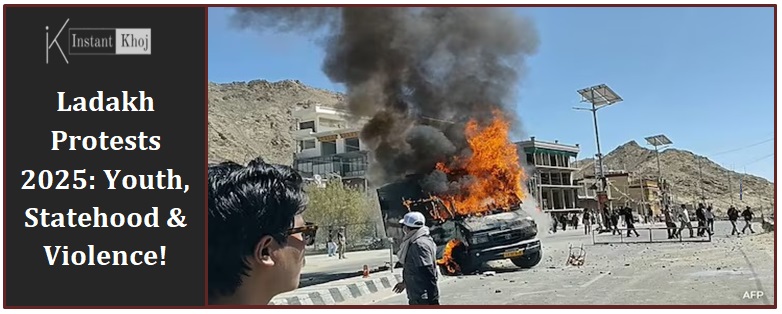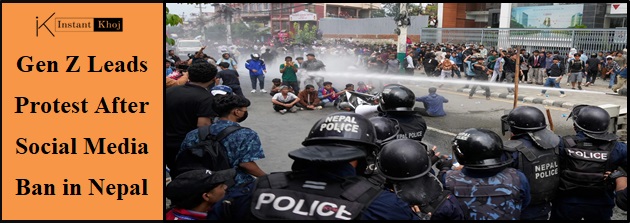Ladakh, one of India’s remote Himalayan regions, has recently witnessed serious violence, protests, and unrest. Residents are deeply upset with the government over issues like political rights, environmental protection, and job opportunities. This article explains what led to the violence, what has happened, and what may come next.
What Sparked the Unrest
Loss of Promised Rights & Autonomy
-
In 2019, Ladakh’s special status (when it was part of Jammu & Kashmir) was removed, and it became a Union Territory directly governed by New Delhi. Many felt this change reduced local power and local identity.
-
Locals want statehood for Ladakh (i.e. becoming a full state rather than a union territory) and inclusion under the Sixth Schedule of the Indian Constitution. The Sixth Schedule offers protections for tribal regions — more local power, protections for land, culture, decision-making.
Frustration Among Youth & Broken Promises
-
Many youngsters believe promises made by political leaders (including the ruling party) have not been kept. They point to joblessness, poor infrastructure, loss of livelihood.
-
Hunger strike by activist Sonam Wangchuk began around September 10, 2025, to press these demands peacefully. But after over two weeks, two hunger strikers got ill, which triggered wider protests.
How the Protests Escalated
The Spark
-
When the health of two hunger strikers deteriorated, supporters initiated a regional shutdown in Leh (capital of Ladakh) and started marching.
-
Protests involved large gatherings at memorial grounds and local streets. Youths played a big role.
The Violence
-
Clashes broke out between protesters and police / paramilitary forces. Stone‐pelting, arson (setting fire to BJP office, a police vehicle), damage to public property.
-
Authorities used tear gas, batons, and reportedly firing in some cases.
Casualties and Response
-
At least 4 people killed, dozens injured (varied numbers—some reports say ~45, some say ~80) including police personnel.
-
Dozens arrested (some reports ~50) in Leh and other affected areas.
-
Curfew imposed, movement restrictions, ban on large gatherings (five or more people), shops closed, internet speed disrupted or cut.
Why This Moment Is Important
-
This is one of the worst protests in Ladakh since 1989. The scale of violence, the number of injured, has alarmed many.
-
The role of youth (Gen Z, students) is significant. Many feel the older methods of protest (shut‐downs, petitions) aren’t working anymore.
-
Environmental concerns are also central: Ladakh’s glaciers are under stress; locals worry about land exploitation, loss of grazing lands, and ecological damage especially with increased militarization.
Key Demands of Protesters
-
Statehood for Ladakh — give full political status like other states.
-
Sixth Schedule protections — to preserve tribal rights, land rights, local decision making.
-
Job reservations and priority for Ladakhis in government services.
-
Separate Lok Sabha seats (national parliament representation) for Leh and Kargil.
-
Protection of land, ecology, and traditional livelihood from outside exploitation.
Government’s Position & Reactions
-
Government (Centre and local authorities) blamed activist Sonam Wangchuk for inciting protests. They allege provocative speeches referencing foreign protest movements contributed to the unrest.
-
They also said that police had to act when property was attacked, and violence escalated.
-
Authorities imposed curfew, detention orders, restrictions on gatherings, to restore order.
Impact on People & Region
-
Loss of life and injuries: trauma in families, fear among residents.
-
Disruption of daily life: businesses closed, curfews, restrictions on movement, internet slowdown.
-
Damage to property: government buildings, political party offices, vehicles etc.
-
The possibility of further unrest if demands are not addressed; tensions could worsen.
What Might Happen Next
-
Dialogue: Discussions are expected. One official meeting is scheduled for October 6, 2025, between Ladakhi representatives and central government.
-
Investigation into deaths & accountability. Many are calling for fair, impartial probe.
-
Potential government response in policies: maybe grants of special protections (like Sixth Schedule), more representation, job quotas.
-
If demands are ignored: possibility of more protests, increased anger among youth, possible wider unrest.
Conclusion
Ladakh is at a turning point. After years of neglect and broken promises, people — especially the young — feel their patience has run out. The latest protests reveal deep dissatisfaction with how governance, political rights, and environmental protection are managed. What happens in the next few weeks will matter a lot: whether authorities listen and respond, or whether things worsen.
FAQs about Ladakh Violence & Statehood Protests
Here are some common questions people ask about this incident and the broader movement:
1. What is the Sixth Schedule and why do people want it in Ladakh?
The Sixth Schedule is part of the Indian Constitution. It gives special rights to tribal regions: local self-rule through councils, protection of land and forest resources, safeguarding of local culture. Protesters believe Ladakh needs those protections to prevent outside control of land and resources.
2. Who is Sonam Wangchuk and what role has he played?
Sonam Wangchuk is a Ladakhi climate activist and educator. He started a hunger strike demanding statehood, protections under the Sixth Schedule, job rights, etc. His strike and speeches raised awareness, and many supported him. He ended the strike when violence broke out.
3. How many people have been killed or injured so far?
At least 4 people are confirmed dead. Depending on the source, around 45 to 80 people are injured, including police/paramilitary personnel. Some injuries are serious.
4. Why did the protests turn violent?
The protests began peacefully (fasting, demonstrations). Violence broke out after two hunger strikers were hospitalized, which angered supporters. There was damage to property (vehicles, buildings), and clashes with police escalated. Some protesters used arson or stone‐throwing; police responded with force.
5. What has the government done in response?
-
Imposed curfew in Leh and other towns.
-
Banned large gatherings (five or more).
-
Restricted movement, shut businesses.
-
Arrested dozens.
-
Promised talks and reviews.
6. What are the risks if demands are not met?
-
More violence and unrest.
-
Further alienation of local communities.
-
Environmental damage might worsen.
-
Possible political instability.
7. Can this movement succeed peacefully?
Yes, it can. Many only want dialogue, recognition of rights, constitutional safeguards. Peaceful methods (fasts, marches, legal petitions) have been used. The key is whether the authorities listen and genuinely engage with demands.
Also Read:
Gen Z Leads Protest After Social Media Ban in Nepal
Nepal Crisis: PM Oli Resigns After Ban & Gen Z Protests
FollowCurrent AffairsonInstantkhoj for more latest stories and trending topics.




